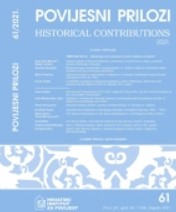Jeruzalemski hodočasnici s Iberskoga poluotoka u hrvatskim krajevima (1400. – 1650.)
Jerusalem Pilgrims from the Iberian Peninsula in the Croatian Lands (1400-1650)
Author(s): Krešimir KužićSubject(s): Christian Theology and Religion, Cultural history, History of Church(es), Social history, Culture and social structure , 15th Century, 16th Century, 17th Century, Source Material
Published by: Hrvatski institut za povijest
Keywords: Spain; Portugal; pilgrims; Franciscans; Holy Land; Croatia; Adriatic;
Summary/Abstract: Pilgrims from the Iberian Peninsula, from the kingdoms of Castile, Aragon, Navarre, and Portugal, were an indispensable part of European pilgrimages from Venice to Palestine from the very beginning of travels to the Holy Land (a total of 85 persons have been recorded from the lands of the Spanish Crown and 68 of those have been identified; 60 of them came from Portugal, 32 of them known by name). This is evidenced by Venetian state and chronicler records, but above all by the relatively numerous travelogues (6 Spanish and 3 Portuguese authors have been analyzed). Motivated by deep and sincere religious feelings, of which one finds confirmation in their writings as well as in general biographies, they set out from all parts of their countries on this expensive, tiresome, and too often perilous sea voyage. Very similar to the German or French pilgrims, they came from all walks of life, but persons from ecclesiastical circles prevailed from the mid-16th century. Somewhat surprising is the large number of women, which generally differs from the situation in other ethnic groups. Due to their choice of Venice as the port of departure, they had to sail along the Croatian Adriatic coast. Some, however, used new geographical discoveries and came to Jerusalem from the east, visiting the Adriatic cities only on their return. Depending on the type of vessel (galley or one of the proper sailing ships – cocca, nave, or galleon) and the official or business tasks of the ship owner, they docked in various ports from Poreč to Dubrovnik. And while members of the nobility recorded secular curiosities, with a noticeable liking for “miracles”, the clergy placed considerable emphasis on the religious situation. In this respect, what united them was their surprise at the encounter with Glagolitic liturgy (the question is what impressed them more – the Mass in Zadar or the singing in Jerusalem). St Jerome was recognized as a strong link between his native Dalmatia and the distant Iberian lands. The political reality was quite astutely perceived and the pilgrims knew about all various changes – the attitude of Dubrovnik towards the Holy Roman Empire, the Venetian territories from Istria to Boka, and the intolerance between Venice and the Dubrovnik Republic – but the political Croatia escaped their observations.
Journal: Povijesni prilozi
- Issue Year: 2021
- Issue No: 61
- Page Range: 327-396
- Page Count: 70
- Language: Croatian

